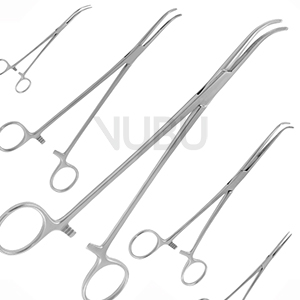Dissecting forceps and ligature forceps are indispensable tools in surgical practice. They are characterized by their short handles and slight curvature, which allow for precise handling in tight and hard-to-reach anatomical areas. Their serrated jaws enable blunt dissection of tissue while also securely ligating vessels after transection. These versatile features make them essential instruments in a wide range of surgical procedures.
Short Handles: The compact design ensures precise control and is ideal for procedures in confined anatomical spaces.
Slight Curvature: The curvature of the clamps facilitates access to deeper structures and improves visibility during surgery.
Serrated Jaws: The serrations on the jaws provide a secure grip on tissue or vessels without causing damage. This is particularly important for blunt dissection or ligation of blood vessels.
Material: The clamps are made from high-quality surgical stainless steel, which is corrosion-resistant and sterilizable, ensuring long-lasting durability and reliability.
Dissecting Clamps: Used to bluntly dissect or mobilize tissue without the need for sharp instruments. They are particularly useful for dissecting fascia, lymph nodes, or soft tissues.
Ligature Clamps: Used to clamp blood vessels before transection and to ligate them afterward to control bleeding. They are essential in vascular surgery and laparoscopic procedures.
Among the most well-known and proven models are the clamps by Mixter, Gemini, Rumel, and Kantrowitz. Each of these clamps has specific features that make them particularly suitable for certain applications:
Mixter Clamp:
Description: A straight or slightly curved clamp with long, slender jaws.
Applications: Ideal for tissue dissection and vessel ligation in general and thoracic surgery.
Advantages: Precise handling and versatile use.
Gemini Clamp:
Description: A shorter clamp with serrated jaws and a strong curvature.
Applications: Frequently used in vascular surgery and laparoscopic procedures.
Advantages: Secure grip and easy handling in tight spaces.
Rumel Clamp:
Description: A clamp with a unique fenestrated design that facilitates vessel fixation.
Applications: Particularly useful in cardiac surgery and for controlling large vessels.
Advantages: Reduces the risk of vessel damage.
Kantrowitz Clamp:
Description: A clamp with a strong curvature and broad jaws.
Applications: Often used in thoracic surgery and for treating aneurysms.
Advantages: Robust construction for demanding procedures.
Our dissecting and ligature clamps undergo strict quality control and comply with international standards for medical instruments, including DIN ISO 13485 and 9001. This ensures that each instrument meets the highest requirements for safety, effectiveness, and durability. Additionally, our clamps are CE-certified, confirming their compliance with European regulations.
Ergonomics: The clamp design reduces hand fatigue during lengthy operations.
Versatility: Available in various sizes and curvatures to meet the demands of different surgical procedures.
Sustainability: The use of durable materials contributes to the reduction of medical waste.
Dissecting and ligature clamps are indispensable tools in modern surgery. With proven models such as the Mixter, Gemini, Rumel, and Kantrowitz clamps, we offer instruments that stand out for their precision, safety, and reliability. By adhering to the highest quality standards and using premium materials, we ensure that our clamps meet the demands of complex surgical procedures.
